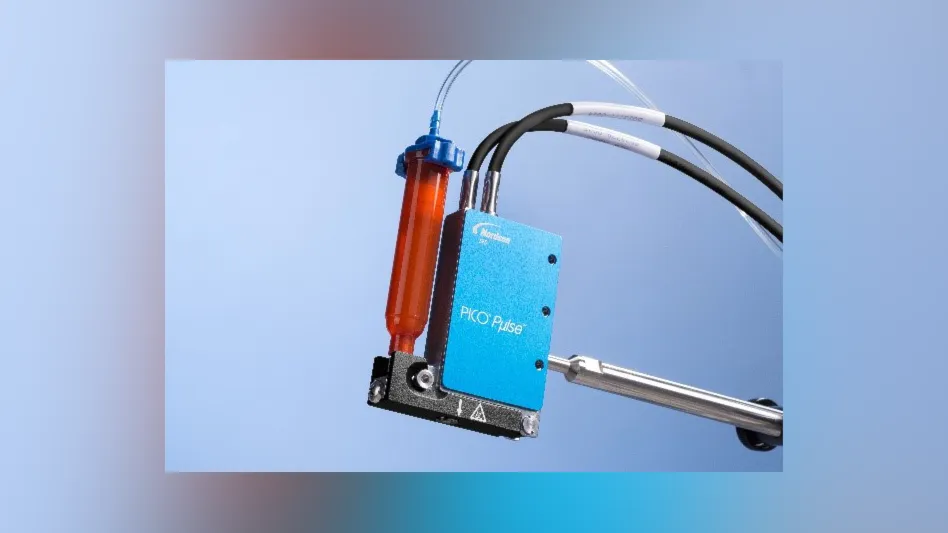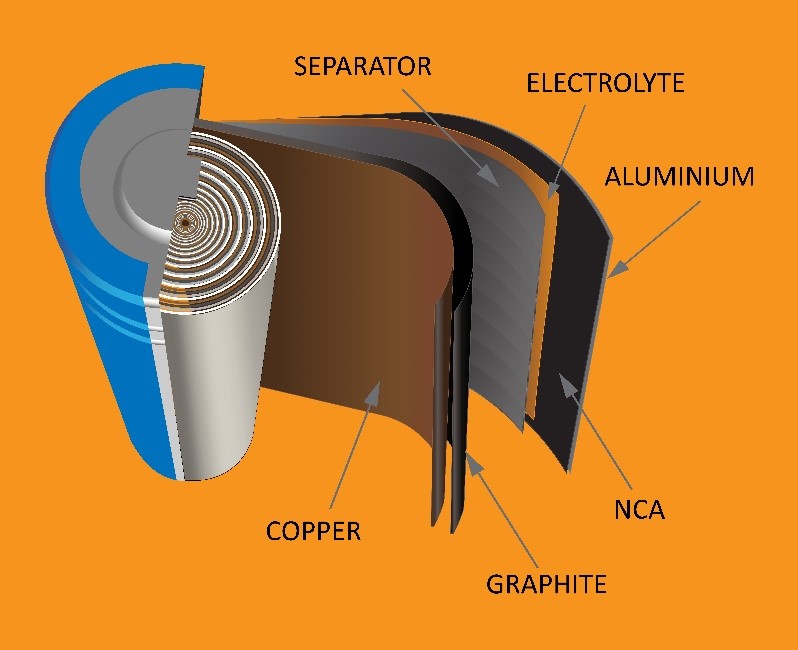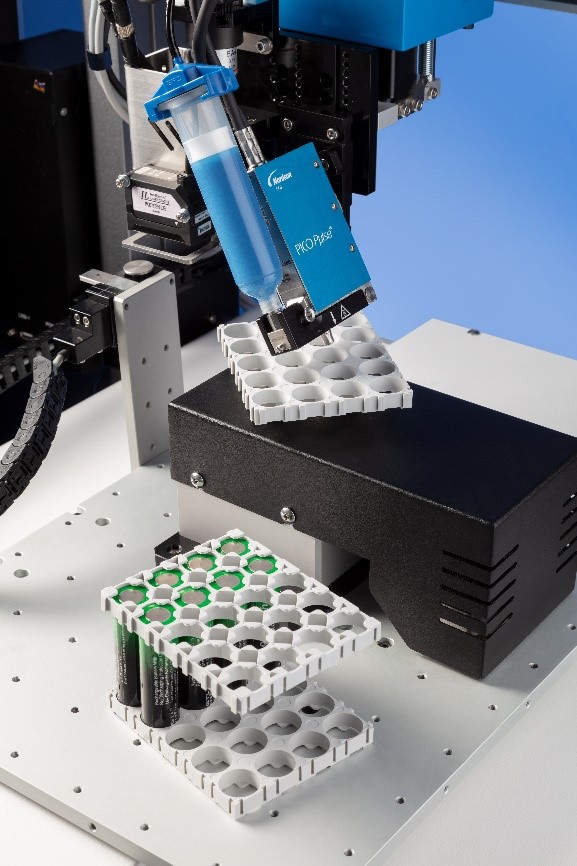
Courtesy of Nordson EFD
With the advent of the age of electric vehicle (EV) mobility, the worldwide demand for lithium-ion (Li-ion) batteries is soaring. National industrial policies and manufacturing investments are being made to ensure that the United States is equipped to meet the demand for EV batteries. More than 30 new battery manufacturing plants are planned to be built in the United States, critical for the future of eMobility.
But beyond making these essential manufacturing investments, to meet the coming demand battery manufacturers need find ways to improve their processes to be successful in this rapidly expanding market. More flexible and efficient processes across all fields of cell, module and pack manufacturing are essential to realize successful battery production and speed up time to market.
Lithium-ion batteries for EVs
Li-ion batteries are the key to the performance of an electric vehicle. Their lifetime and quality determine the driving range and overall safety. As a result, design engineers spend significant time optimizing the battery management system and the thermal management of the entire battery pack.
Two main types of Li-ion batteries are used in EVs – cylindrical cells and prismatic cells. Here is a quick overview of their structure:
Cylindrical cell

A Li-ion cylindrical cell consists of sheet-like anodes, separators and cathodes that are sandwiched, rolled up and packed into a cylindrical can. The advantage is its mechanical stability. The round shape of the battery distributes the internal pressure from side reactions over the cell circumference almost evenly. This allows the cell to tolerate a higher level of internal pressure without deformation.
For battery technology to operate as intended, precise alignment between the cathode, anode, and separator must be maintained. Fluid dispensing expertise from Nordson EFD is essential for recommending the correct solution for the exact, repeatable application of adhesive to facilitate accuracy in battery layer alignment within the cell.
When combining EV cylindrical cells into packs and modules, the cells’ circular cross-sections do not allow them to fully utilize the available space. As a result, the space cavities let coolant easily circulate around the cells within a battery pack.
Prismatic cell
A prismatic Li-ion cell’s chemistry is enclosed in flat or rectangular shapes typically encased in steel or aluminum; these shapes allow for efficient stacking of multiple units in a battery module.
There are two types of prismatic cells – one includes stacked cells, and the other includes rolled and flattened cells. For the same volume, stacked prismatic cells can release more energy at once, offering better performance, whereas flattened prismatic cells contain more energy, offering more durability.
When EV prismatic cells are combined into packs, the cell box-like shape enables optimal use of the available space. However, this optimal space is achieved at the cost of more challenging thermal management because there are no space cavities between the cells.
Industry estimates indicate that the battery is one-third the cost of an electric vehicle. As the market demand for EVs continue to increase, cell manufacturers need to address this demand by using efficient manufacturing processes to reduce the cost of the battery pack.
Fluid dispensing in EV battery assembly
A major factor in improving the efficiency of EV battery manufacturing is fluid dispensing of UV-cure adhesives, electrolytes, silicones, and thermal interface materials within the battery pack.
These deposited fluids provide the necessary mechanical strength, thermal conductivity and chemical inertness to last throughout the life of the battery. The tiny amounts of adhesive, silicone, and other fluids must be dispensed reliably and accurately in dosage and placement. The precise positioning and quantity of these fluids deposited on the parts is critical to the battery’s assembly, function, quality, safety, appearance, and viability.
Dispensing of fluids onto hard-to-access areas, uneven or irregularly shaped surfaces, or delicate substrates of the Li-ion battery are key factors that need to be carefully assessed as they can considerably impact assembly production. These directly affect the Z-axis movement of the dispensing system, influencing its ability to move over uneven surfaces and dispense the correct volume of fluids in the right locations. Cycle times for fluid dot deposition and throughput rates are regulated to some extent by the substrate surface topography.
Fluid dispensing in the assembly of EV battery components encompasses a range of methods that can accommodate specific fluid application processes with a wide scope of functionality.
The latest automated dispensing equipment provide a high degree of process control, capable of dispensing adhesives, solder pastes and other assembly fluids with high consistency. Handling fluid dispensing of dots, beads and fills under a broad range of conditions, these units are equipped with multiple capabilities to refine the dispensing process.
From precision benchtop fluid dispensers, pneumatic valve systems, progressive cavity pumps, piezoelectric jetting valve systems, and in-line automated dispensing systems, there are a number of factors that would support adopting a more efficient and controlled dispensing method in the assembly of batteries for electric vehicles:
1) Shot-to-shot repeatability and accuracy are considerably improved as a more automated and controlled dispensing approach is employed.
2) Increased productivity is clearly a benefit that comes with increased automation.
3) Part quality improves when switching to in-line automated dispensing because operator-to-operator variance is significantly reduced. The ability to set precise dispensing parameters for an application improves process control and ensures the right amount of fluid is placed on each part.
4) Rework and reject rates lessen when using automated dispensing solutions, thus improving the yield of the manufacturing lines and greater profitability to the manufacturer.
5) The amount of assembly fluid used decreases significantly when using a more controlled method of dispensing.
Whether applying UV-cure adhesives to a battery module assembly, or the fluid dispensed to adhere the anode and cathode layers, characterizing different fluids and determining the best dispensing parameters for a specific application are important factors for implementing a successful dispensing process for any EV battery component assembly.
Shot-to-shot repeatability, accuracy and process control
Shot-to-shot repeatability and accuracy are absolute critical factors in fluid dispensing, and with particular importance in the manufacture of EV battery components. Depositing the right amount of fluid has a compounding consequence of not only maintaining product integrity, but also keeping downstream production moving. The latest generation of fluid dispensers can distribute practically all assembly fluids with precise accuracy.
Another feature supporting precision dispensing, which is particularly applicable for EV battery manufacturers, is Automated Optical Inspection (AOI). When coupled with CCD cameras and confocal lasers, vision-guided automation platforms provide optical assurance of fluid deposit volume and placement accuracy, ensuring a conforming deposit.
With robotics, using the robot's existing vision systems, the AOI software verifies fluid deposit widths and diameters. With the AOI confocal laser, the system measures the height of a fluid deposit in addition to the width and diameter, providing 3D deposit verification and determines if dispense requirements have been met. The confocal laser detects deposit height measurements regardless of the transparency of the fluid, which can sometimes distort quality data. Constant closed-loop feedback delivers automated quality control data, saving battery manufacturers time and costs.
EV battery cell assembly and module production
Jet valves, dispense valves and automated dispensing systems help manufacturers produce high-performance, defect-free batteries at faster production speeds by applying precise amounts of assembly fluids within tight deposit size and positional tolerances. Several types of dispensing solutions are used to produce the Li-ion battery cells and modules used to power electric vehicles.
Battery cell and module dispensing applications for EVs require various low- to medium-viscosity adhesives to glue components together. Within the battery management board of EV battery packs, precision valves are required to dispense extremely precise amounts of UV-cure adhesives and other assembly fluids.
Adhering anode, separator, and cathode layers
This process requires small, precise amounts of material to be applied to attach more than 100 thin electrode layers in the production of cylindrical and prismatic Li-ion batteries. The application requires a very fast dispense time between one and four seconds per dot of UV-cure adhesives applied between the anode, separator, and cathode layers of each battery cell.

For this application, jetting systems provide the most control at the high speeds required for this dispensing application. Jetting systems like the Nordson EFD PICO Pµlse jets fluid deposits as small as 0.5 nL at up to 1000Hz with bursts up to 1500Hz (deposits per second) continuously. Since it does not require Z-axis movement, the PICO Pµlse can jet extremely accurate, repeatable deposits over uneven surfaces.
Expanding on this capability, Nordson EFD recently released the PICO Pµlse XP piezo jetting system. This jetting valve system is designed to maintain precise, repeatable non-contact fluid dispensing valve-to-valve, after maintenance, and regardless of external factors such as temperature changes. Its sustained stroke target seeking functionality permits the valve to self-adjust to maintain a micron-level stroke setting for long periods, despite changes in environmental conditions that can alter dispense results over time.
Electrolyte cell filling
The dispense process must be able to withstand the corrosive properties of the electrolyte and dispense accurate, repeatable amounts of material to transport the positive lithium ions between the cathode and anode layers.
The solution is a valve with an acetal copolymer fluid body for dispensing corrosive materials, such as electrolytes. One such valve is the Nordson EFD 702V-A Series mini-diaphragm valve, its unique design prevents trapped air and bubbles from affecting the quality and performance of battery cells.
Battery top sealing
Accurate, repeatable amounts of UV-cure adhesive are required to seal the top of cylindrical and prismatic battery cells to prevent short-cuts. Jetting dispense systems provide the speed and accuracy needed to keep up with the throughput and quality assurance requirements of this application.
Thermal management
Thermal runaway is a significant threat to the safety of a battery pack, and to the Electric Vehicle in operation. One method to prevent thermal runaway is the use of thermal interface materials (TIM) since the material absorbs the heat from the overheated batteries. To achieve this, design engineers need to calculate and precisely apply the right amount of the selected TIM chemistry at the exact locations in the battery module and the battery pack. The ability to accurately apply the right fluids for managing thermal conductivity precisely where they are required is one of fluid dispensing technology’s unique capabilities.
TIMs are dispensed to draw heat away from sensitive components, and toward outer casings or heat sinks.
In the applying of TIMs to battery manufacturing, the conventional approach has been to apply thermal tape or thermal gap pads manually instead of thermal grease because of cost reductions. But the pads do not always conform to different gap geometries, which does not allow consistent coverage of thermal material on the part.
For some EV battery TIM applications, manufacturers use a handheld fluid dispenser to apply fluid manually, which allows coverage that thermal tape and gap pads do not always provide. But dispensed manually, coverage inconsistencies frequently occur due to operator-to-operator variability.
A solution to this issue is progressive cavity pumps, such as Nordson EFD's model 797PCP progressive cavity pump, which is designed for applying thermal paste into battery heat sinks. The pump provides a perfectly sealed metering chamber that prevents shear, pulsation, and squeezing of the fluid that can sometimes crush delicate fillers and particles used in thermal pastes. The pump delivers highly precise fluid volume accuracy and repeatability at +/- 1%, for consistent fluid application.
Potting and sealing electrical battery components
Potting and sealing electrical components helps prevent moisture or other foreign matter from entering the battery case and causing malfunctions. For potting applications, Nordson EFD’s 797PCP-2K progressive cavity pump provides repeatable volumetric filling of small cavities.
For sealing applications requiring microdots, Nordson EFD’s xQR41 Series MicroDot needle valve maintains UV-cure adhesive deposit size as small as 150 µm in diameter, and features an adjustable needle stroke, which allows the user to maintain exact deposit size.
The automated optical inspection software and confocal laser, OptiSure Automated Optical Inspection (AOI) system, also by Nordson EFD, can be used with vision-guided robots to provide optical assurance of fluid deposit dimensions and placement for precise quality control.
PCB conformal coating and sealing
Coating densely populated EV battery PCBs is critical to waterproof and prevent corrosion and oxidation. This requires precise deposition of conformal coating fluid, into narrow, hard-to-reach areas without over deposits and migrating of the coating, which could lead to contamination of other parts of the board and potential product failure.
Manufacturers commonly use a film coater to selectively apply conformal coatings. To facilitate application with this system, the coating is frequently diluted with a solvent to improve its flow characteristics. Thinning can lead to over-deposits onto areas where coating should not go, potentially reducing the integrity of the coating to effectively protect the board and adding production steps to manage the over-deposits.
Replacing the film coater with a jetting valve, such as the PICO Pµlse jet valve, allows manufacturers to apply the exact amount of conformal coating needed without diluting the fluid first. The jet valve provides precision dispensing control at high speeds up to 1000Hz (cycles per second), resulting in reduced voids in the dispensing area, increasing first-pass yields.
Final battery assembly
Case bonding and gasketing completes the full battery assembly, adding final structural rigidity and protection. Typically, epoxy or silicone materials are used, both offering fast curing times and making the battery pack waterproof, reopenable and serviceable.
Robotic fluid dispensing
Robotic dispensing has evolved to support the needs for higher throughput EV battery manufacturing by developing specialized dispensing technology for automated inline assembly and manufacturing systems, and for stand-alone production devices.
Many applications involve attaching a valve to a 6-axis robot arm, or using the valve with a 3-axis tabletop robot. An example is mounting a PICO Pµlse jet valve on Nordson EFD’s vision-guided 3-Axis EV Series automated fluid dispensing robot for conformal coating in densely populated battery PCBs. When combined, the exact amount of fluid is applied in the exact location required on the PCB.
Robotic dispensing systems, such as the Nordson EFD GV Series gantry fluid dispensing robot, provide the conveyor-fed assembly required by Li-ion EV battery production. The robot's 3D motion control allows programming of dots, lines, circles, arcs and compound arcs. Fluid deposit placement and accuracy is verified with automated optical inspection (AOI) software. When paired with the system's confocal laser on Nordson EFD’s vision-guided PRO and PROPlus Series automated fluid dispensing robots, the AOI system measures the height of fluid deposits, in addition to width and diameter, providing 3D dispense verification.
Requirements for robotic fluid dispensing in EV battery production are as varied as the differences in production environments. Identifying these requirements will facilitate the selection of the most optimum dispensing and robotics system for the application.
Latest from EV Design & Manufacturing
- Archer completes installation of high-volume battery pack manufacturing line
- Siemens Xcelerator as a Service expands across the product lifecycle
- Lyten ships lithium-sulfur battery A-samples for automotive, consumer electronics, and military customer evaluation
- Latest advancements in machine tool technology
- Visit Okuma America at IMTS 2024
- Eaton to supply ELocker differential system to leading electric vehicle manufacturer
- AM for Aircraft Cockpit Interior Components
- Addionics and IL Science sign MOU to develop next-gen high-performance lithium metal batteries





